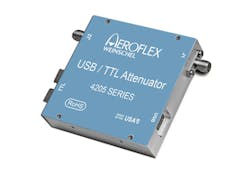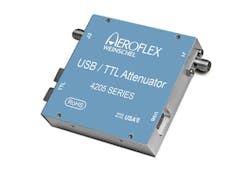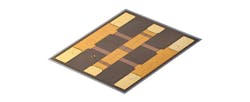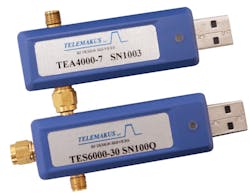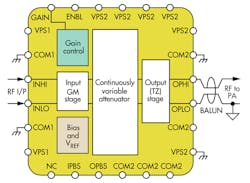Price, Power, And Size Drive Attenuator Advancement
This file type includes high resolution graphics and schematics when applicable.
The boon of wireless-communications technologies has affected every component in the RF/microwave signal chain. The need to fit higher-frequency and higher-power signals through various antenna technologies is pushing the boundaries for integration and surface-mount technologies. This is a significant challenge for attenuator designers, as the ability to dissipate heat resulting from the attenuation of powerful signals is a challenge in compact areas. Additionally, maintaining component tolerances under such a wide range of frequencies, power levels, and thermal fluctuations demands more complex solutions (Fig. 1).
Related Articles
• Programmable Pad Attenuates 40 GHz
• Attenuator Systems Pad To 6 GHz
• Attenuators Hold Constant Phase
Attenuator specifiers also are demanding that these components be offered at lower prices for bulk purchases. More advanced digital-control mechanisms also are hot on the list of recent requirements. With all of these demands, attenuator designers have been forced to create innovative solutions. New doors have been opened by attenuator technology that boasts high precision, small integrated-circuit (IC) footprints, digital control, and programmability while being packed in modules that are complete with amplifiers and filters.
Be it a massive multi-kilowatt attenuator or a micromechanical IC attenuator, design is being driven by the demands for higher frequencies, more power for the footprint, broader bandwidth, and lower costs. Additional concerns over passive-intermodulation (PIM) distortion are beginning to rise as channel densities continue to increase. These concerns are leading engineers to use higher-precision equipment with smaller tolerances to manufacture coaxial and surface-mount-technology (SMT) attenuators.
According to Jimmy Dholoo, vice president of engineering, Aeroflex/Weinschel, “Another growing trend is low intermodulation performance from high-power attenuators used in mobile applications. It is rather difficult to obtain low levels of IM3, IM5, etc., from conventional thin-film-based attenuators. For the lowest IM levels, one has to use long lengths of a high-quality coax cable, which can result in impractical package sizes. Usually, a compromised IM level is acceptable for high-volume systems.”
Several companies, such as Microlab, RD Microwaves, Signal Inside, and Renaissance Electronics, offer low-PIM attenuators from -165 to -145 dBc. Currently, PIM considerations have only extended low-PIM design to high-power coaxial attenuators. As more power is forced through SMT and chip attenuators, low-PIM designs will begin to surface. This will be necessary to compensate for the smaller-channel bandwidths and higher frequencies passed through these devices.
Designing for high-frequency operation requires smaller physical device dimensions. Avago, Hittite, Skyworks, and RFMD all offer attenuators in either chip or SMT packages (Fig. 2). These devices can operate to 50 GHz, 86 GHz, 40 GHz, and 18 GHz, respectively. Both Avago and Hittite offer voltage-variable analog attenuator chips based on monolithic gallium-arsenide (GaAs) IC technology. They are designed for satellite communications, test equipment, and millimeter-wave high-capacity radios, among other applications.
According to Skyworks, its fixed attenuation pads have enhanced flatness across their broadband operation. Skyworks and RFMD SMT attenuators are available in a variety of digital or analog variable packages. When asked about what new technologies are coming to the forefront with these chip and SMT attenuators, Gary McDermott, Skyworks’ Product Line Director, notes, “Silicon-on-insulator (SOI) is driving integration and electro-static-discharge (ESD) levels, functionality, and cost. Chip-scale packaging/bumped die is also leading to smaller packages. In addition, pHEMT is enabling faster switching times and greater power handling.”
The evolution of attenuator design is nurturing the development of new distributed antenna systems (DASs) and phased-array antennas, which require enhanced control methods to properly direct EM radiation in the right amounts to the right antenna components. Dholoo notes, “There are higher-power demands at higher frequencies for coaxial and chip attenuators for microstrip mounting. Also considered are flat-pack attenuators for systems integration, such as DAS. Several features--like make-before-break for solid-state programmable attenuators, USB interface for lab integration, and TTL interface for subsystems integration--are also influencing design.”
To enable these capabilities, attenuators are being designed with more control customizability. Traditionally, attenuators came in switched, step, or continuously variable forms controlled by turn-knobs and switches. In contrast, variable attenuators now come in a variety of packages with parallel, serial, and programmable designs. Avago, Hittite, Skyworks, RFMD, Mini-Circuits, and Pasternack all offer variable and programmable designs in a range of form factors.
Fairview offers a switchable attenuator that can be switched while “hot” for continuous operation. It operates to 6 GHz while providing attenuation to -35 dB. Benchtop offerings from Trilithic claim to attenuate to -110 dB at 1-dB steps with accuracy of approximately 0.25 dB.
High-customizability designs for test and measurement also are driving unique design solutions for variable and programmable attenuators. Skyworks’ McDermott says, “Customers require fewer tests and less calibration of the final product, support of the newer/higher-frequency LTE bands, more compact systems, simpler control schemes like serial or step over parallel structures, and lower costs.” NI offers a PXI programmable RF attenuator operating to 8 GHz with an attenuation range to -60 dB and a variable step of 0.5 dB. Telemakus offers a Universal Serial Bus (USB) programmable attenuator line, which is programmed via a graphic interface. It operates to 13 GHz with attenuation to -30 dB and a step size of 0.5 dB (Fig. 3).
With new capabilities, opportunities for new applications arise. When asked about new applications for attenuators, Norm Hansen, vice president sales and marketing of Aeroflex/Inmet, noted ,“Gain compensation over temperature—low-decibel-value attenuators are being added to system designs not because attenuation is desired, but because that change in signal level as a function of temperature is desired.”
This file type includes high resolution graphics and schematics when applicable.
In Support Of Integration
This file type includes high resolution graphics and schematics when applicable.
Integrating multiple functions into compact modules is becoming necessary to meet the needs of RF/microwave component customers. Highly integrated devices, such as variable gain amplifiers (VGAs), offer a wider range of uses than a standalone attenuator (Fig. 4). VGAs are used to condition signals with a programmable voltage gain. To accomplish this, some VGAs are designed with variable attenuators in the same signal chain as a fixed gain amplifier. This enables those VGAs to offer signal attenuation and amplification in the same device. In doing so, they can meet the testing and operational needs of a variety of applications. In communications setups, a VGA could be used to adjust the voltage input into a cable system to maintain signal integrity and amplitude despite the cable length or receiver configuration.
Agilent and RFMD both offer VGAs that can operate in the gigahertz range and either amplify or attenuate signals. These devices are designed as components of cellular systems. Agilent offers a VGA with an output frequency range of 0.25 to 2.4 GHz, gain ranging from 5 to -30 dB, and a 1-dB step size. RFMD reports that its VGA has a frequency range of 0.05 to 4.00 GHz with gain of 18 to -13.5 dB and a step size of 0.5 dB.
Related Articles
• Programmable Pad Attenuates 40 GHz
• Attenuator Systems Pad To 6 GHz
• Attenuators Hold Constant Phase
An RF vector multiplier can operate as a variable attenuator, phase shifter, multiplexer, and vector modulator. It is composed of a matched pair of broadband VGAs with summed outputs. Separate gain controls enable independent and linear-in-magnitude control. Agilent and Maxim Integrated are examples of companies that offer vector multipliers operating in cellular bands.
Today, the trend for RF/microwave attenuators is to provide on-demand customization in a wide range of package sizes. For designers, this trend translates into demands for tighter phase variation, higher accuracy, low PIM, and higher resolution. Higher-frequency operation, higher power, faster switching, and broader-bandwidth demands lead to larger designs that can handle higher-temperature operation.
To keep up with the cellular industry, complex modules with combined functionality and very high bandwidths are needed to stay price competitive. Oftentimes, these design constraints conflict with present technology capabilities, which puts pressure on RF/microwave attenuator designers to stay up to date with the latest materials and technologies.
This file type includes high resolution graphics and schematics when applicable.
About the Author
Jean-Jacques DeLisle
Jean-Jacques graduated from the Rochester Institute of Technology, where he completed his Master of Science in Electrical Engineering. In his studies, Jean-Jacques focused on Control Systems Design, Mixed-Signal IC Design, and RF Design. His research focus was in smart-sensor platform design for RF connector applications for the telecommunications industry. During his research, Jean-Jacques developed a passion for the field of RF/microwaves and expanded his knowledge by doing R&D for the telecommunications industry.
